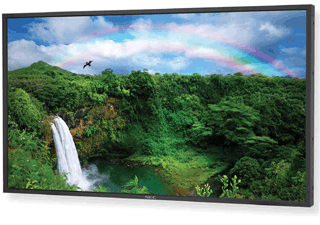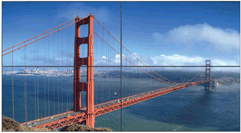- The Sky Is The Limit When It Comes To Flat Panel Mounting Options
In a perfect world, all that would be necessary to install a flat panel display would be to put some Velcro on the back of the display, press a few matching strips on a wall or other flat surface, get someone to help you lift the set, press the set onto the wall, and then stand back and admire your installation masterpiece. Okay, plasma and LCD displays are getting thinner and lighter, but we’re not at that stage quite yet. Holes still need to be drilled, brackets assembled, cables routed, and many other things examined, evaluated, and selected.
Samsung UT Series
Until self-levitating displays that float in space exist, some form of physical attachment is needed between the display and a hard surface capable of supporting it. Indeed, the size and form of today’s flat panel displays has spawned an incredibly wide range of mounts and mounting options, giving the system designer a range of flexibility that was once impossible. At the nexus of displays, applications, and mounts, our goal this month is to review the options available so that you’ll hopefully dream up the perfect solution for bringing a video or data display to your next project.
FIXED DISPLAYS
Easy and reasonably priced, the standard fixed-wall mount is however somewhat limited in versatility. Find the space, put the brackets or rails on the wall and matching rails, plates, or brackets on the set, and you’re good to go...so it seems. With the increasing popularity of thin-depth displays in the consumer world, you’re likely to find a place for them in one of your jobs soon. That, in turn, may change the way you think about what has previously been a simple task. After all, if the mounting system isn’t correct, the distance from the wall surface to the display may be greater than the depth of the display, itself, negating the whole purpose of having a slim set.
Responding to the new thin displays, all of the major mount manufacturers have developed mounting systems that help to keep the slim profile your client is after. Failing that, in some cases the job may be better served through the use of a separate recessed back-box, or with a mount that is engineered from the get-go to retract into an in-wall cavity. If there is one aspect of mounts that has dramatically changed since we last surveyed the scene, this is it. You would be well served by making sure that you are up to date on all the latest options for thin-depth displays.
A variant of the fixed-mount display is what can best be described as a “monitor tree,” something once seen only in command and control applications, engineering workstations, or in specialized situations such as brokerage offices. However, the increased use of two, or even three, monitors on a desktop is becoming commonplace. Here the challenge is one of space and safety, as you’ll need to make sure that everything is stable and that the “wrap” of the monitors—the angle between them and the relationship of their placement to the user’s field of view properly suits the ergonomics of the installation. When you visit a prospect for the first time, or scope the drawings or plans for a job, look around to see how many desks have more than one data or video monitor on them and you may uncover not only a new application for mounting systems, but an additional value-add for the job.
NEC MultiSync Professional Series

Next up the ladder from simple on-wall mounts are tilt-wall mounts, which have sufficient range of motion to allow you to point the display toward the viewers when the display is not at or close to direct eye level. As always, be sure to size these displays properly to the weight of the display, as well as to the specific VESA mounting hole pattern. Equally important, as with any on-wall mounting situation, make certain that proper clearance is maintained between the display and the wall to accommodate any ventilation requirements, particularly for the fans in some of the larger plasma displays.
Last on the rungs of the fixed-display ladder are mounting systems where a plate is attached to the VESA pattern holes on the display, but rather than mounting directly to a wall, some sort of apparatus links the display to a hard surface that is some distance away. Pipe mounts come to mind here, for applications such as corridors where there is no adjacent vertical wall. This is also where some creative thinking and careful consultation with both your mounting systems suppliers and a job’s architect or structural engineers is important when off-wall mounts are attached to truss or hanging systems for applications such as sports bars or clubs. As clever as the mount may be, always make certain that the total structural loads are properly calculated to bear the weight load.This is also where tilt-adjustment will definitely come into play, as the displays will be mounted well above head height. Additionally, you’ll want to begin to look at options for the mount, such as a cradle for any data receiver or computer that might be required, or for center or side speakers (or, perhaps, both!) when audio is localized to the display and not distributed in some other fashion. As with all mounts, when specifying a specific model, always make sure that there are provisions for any needed security or safety accessories and that all needed safety compliances are present.ON THE MOVE
While most installations are likely to be on-wall, either fixed or tilt, the real fun comes when the display starts has to move. In some cases, this might be as simple as a rotation system that shifts the display 90 degrees depending on whether you need portrait or landscape. In more complex situations the display will tilt down out of the ceiling, rise up from a cabinet, or swing out from a wall.Particularly in lodging and hospitality situations, a set needs to swivel from side-to-side, and possibly retract at the same time so that it is back flush on the wall or in a cabinet. For this you’ll want to explore the world of full-motion, articulating mounting systems.With any sort of multi-arm mount, careful planning is required. Make certain that the mount properly channels, or accommodates in some way, all the necessary power and signal cables. (And while you’re at it, make note of the maximum extended length of arms when planning cable runs. You don’t want to come up short here!) Similarly, when movable mounts are required, make certain that your installation is designed to prevent the set from hitting the wall, damaging both the display and the wall. Some mounts anticipate this by including bumpers, if not you can add them yourself.In most cases the set extends out from the wall and then is able to be moved left or right, but in other cases you may want to “fold” the display under a counter. Sometimes this is as simply as a mechanism that simply tilts the set down, but in other cases it will also need to extended or swung to one axis or the other. In some cases this will be done with an application-specific mount, but if you properly figure the needed range of motion there is no reason why, in some cases, a standard multi-arm mount can’t be used provided that there is enough space under the cabinet for the monitor or display in question. Of course, you’ll also want to be very sure that the cabinet is able to support the weight of both conceal a set and only have it become visible when needed is something that is often appropriate for multi-purpose rooms where video or data are not always required.Here, a bit of outside-the-box thinking may give you a design win even if the mount itself is simple. For example, while there are many systems available to reveal and hide a display by moving it, sometimes the job will be better served by a stable display and doors or panels that retract or automatically open and close. Alternatively, sometimes hiding a display may be served by taking a page from a common system on the residential side of the business by using one of the many products that actually “frame” a display as one would a painting, and then have it covered when not in use with artwork. Then, push a button and the art retracts to reveal the display.This is easy enough to describe to a client: have them picture the company or school’s logo, for example, on the wall without a blank screen to district meeting participants when it is not needed. Then, presto, on command the logo or art is gone, and the display lights up—an easy way to make one room serve multiple purposes.Direct view display mount systems have come a long way from simple shelves that both defined and limited installation possibilities. With a bit of knowledge of display mount types, neither the mount nor the display have to define the application anymore. Once you determine where the display needs to go, there is more than likely a system available or adaptable to meet the need. More mounting options, more places where you can put the sets. More places, more sets, well, you get the picture: more for your bottom line!Michael Heiss (CaptnVid@aol.com) is a technology and marketing consultant based in Los Angeles, CA.
